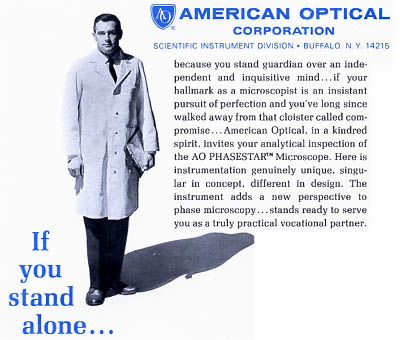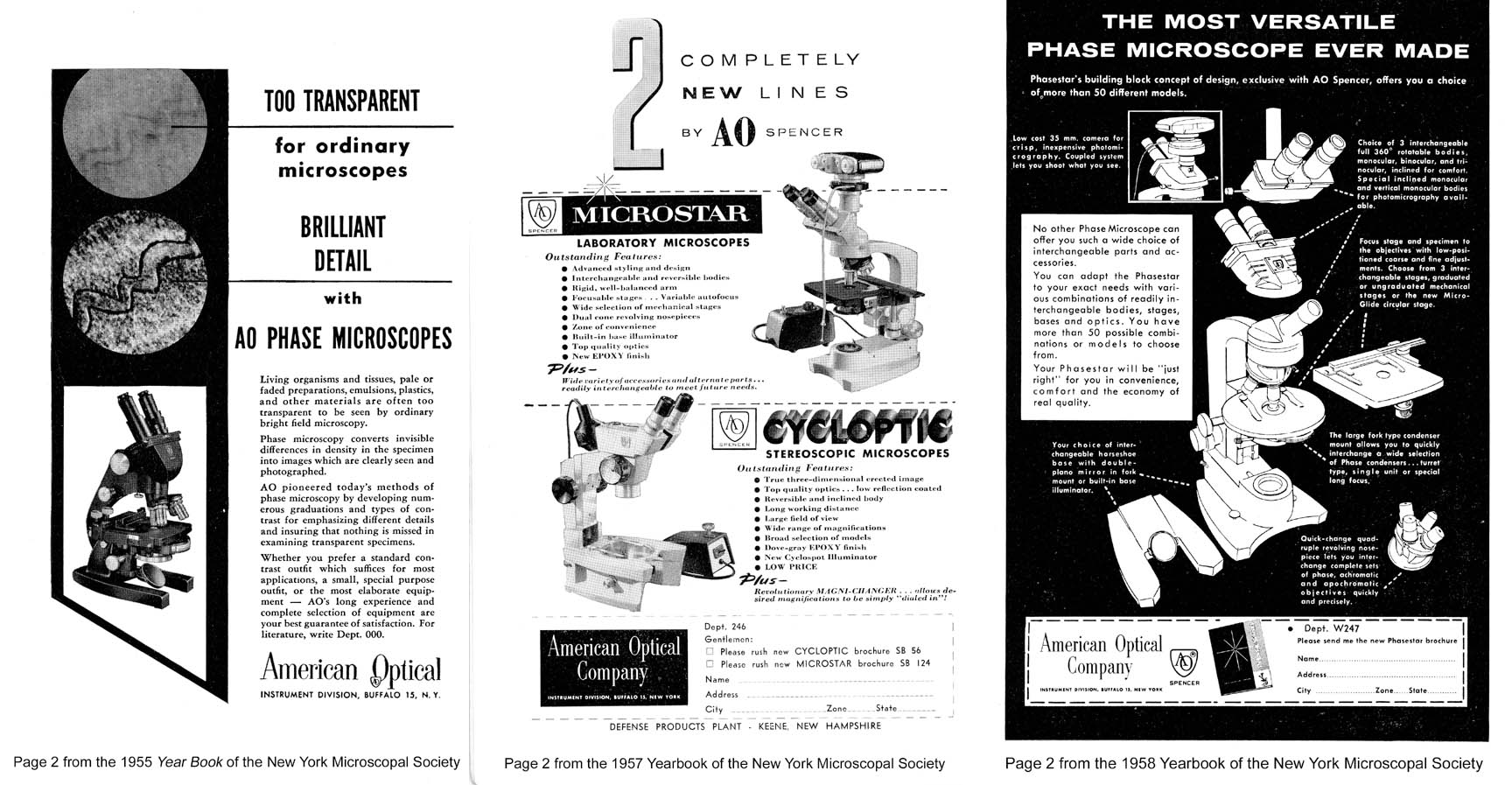

| [Click here to find (interpolate might be more accurate) the date of manufacture of your AO Spencer scope from the serial number (a 122 KB pdf file, courtesy of Jim Solliday)] Note: shussh . . . keep this quiet, as B&L was a fierce competitor to AO Spencer, but you can date your B&L (Bausch & Lomb) microscope here too. ;-) |
Charles Spencer was the first American maker of microscopes, publishing his first catalog in 1838. Later, in 1865, he began operating as C.A. Spencer & Sons. Between 1890 and 1895 the company operated by the name of Spencer & Smith, but in 1895 it became the Spencer Lens Company. American Optical bought the Spencer Lens Company in 1935 and by 1945 it was known as the Instrument Division of American Optical Company. (source: http://www.scripophily.net/amopcom.html). See a timeline by Tom Woods below.
Before 1961, Spencer Lens Co. and AO (American Optical) scopes and their objectives were corrected for a 160mm tube-length . . . with an important exception -- Metallurgical objectives, in contrast, were corrected for infinity.
In 1961, AO (American Optical, with the advent of the Series 10 and 20 scopes, jumped to infinity correction on all it's new microscopes lines. The objectives were still 34mm parfocal**, as they were before this time, but now were corrected for an infinite tube-length rather than 160mm tube-length. This continued right on through the 110 and 120 Series scopes (1980 - 1985).
A pdf of a scan of a very excellent article -- "One Hundred Years of Microscopy in the United States", by Oscar W. Richards -- has been contributed by Dave Jackson and is hosted on Eldred Spell's site. Click here to download the 6.3MB pdf file. This 15 page piece provides an excellent overview of not only Spencer Lens, AO Spencer, and American Optical contributions to microscopy, but other manufacturers as well.
| A walk down memory lane? Not really. These scopes are still 'out there' working. | |
| Click on the thumbnail at the left for AO's view of of it's own history . . . and some nice silhouettes of its historical scopes in 1973 | |
|
|
Click on the thumbnail at the left for some 1937 marketing of Spencer's Series 33 scope. |
| Click on the thumbnail for some AO marketing glitz which actually effectively highlights both the focusable nosepiece and the infinity optics. (again from 1973) | |
| Yes, AO -did- produce DIC scopes! Click on the thumbnail to see a full image of two AO DIC scopes -- it's also a nice intro to DIC principles as well. (1973 again) | |
| Click on the thumbnail for a 1975 look at AO's fine Stereo Microscope lines. I'll take one of each please ;-) | |
| Click on the thumbnail for ad that showed in medical journals in 1981. It appears that AO had just brought out its 'Advanced Plan' line of objectives -- and a 63x Semi-Plan Achro -- and was offering them at special introductory prices. Also of note: the ad reveals that AO had made over 5,000,000 objectives as of 1981 (since 1843). | |
| Click on the thumbnail for a
panoramic view of the AO Series 110 in all it's glory in 1983 -- and a
good example of the breadth of accessories available for AO scopes in
general.
AO and it's line were starting in decline about this time and some consider the earlier AO Series 20 as representing the pinnacle of AO's genius. |
|
In 1985, AO-Reichert, and then named simply 'Reichert' brought out the 310 and 410 line. These scopes were 160mm T.L.* and infinity corrected, respectively. Both adhered to the DIN standard -- being 45mm parfocal.
Below: Eldred Spell provides the following three ads from 1955, 1957, and 1958 to show the transition from the 'Black' scopes to the newer 'Gray' Cycloptic and Series 2/4 line.

*Thanks to Gregg Kleinberg and Wallace Kelly of Yahoo's Microscope Group for checking and correcting this section and for adding the following interesting highlights:
Gregg: "The AO 3000, which was a modular "industrial body" with reflected light, was based on the Series 10 architecture. The only main difference was that the higher power objectives were not cover slip corrected. The AO 3000 was used for many OEM applications (manufacturer uses a modular optical system, in this case from AO, in their own proprietary designed assembly, test, or manufacturing system). Also, the 3000 was very popular for laser beam delivery, for trimming thick film electronic substrates - essentially a tuning step in the manufacturing process. Some special objectives for laser applications were "air-spaced", meaning the lens elements were not bonded with glue - the laser wavelengths would eventually cook and burn the cement, rendering the objective useless."
Gregg: "The 2650 was a reflected light configuration designed primarily to compete with Olympus, Nikon, Leitz and Zeiss for semiconductor inspection. AO special designed brightfield / darkfield objectives for this series, although brightfield only objectives were available as well. As mask & pellicle inspection, and packaged device geometries, became taller in the Z-axis, AO lost any foothold they might have had due to their reluctance to create long working distance objectives for this series. The 2650 was never truly embraced by the marketplace, and are somewhat rare as a result."
Wallace: "One other thing I wanted to mention was that AO actually bought Reichert and AO changed their name to AO Reichert, then as the corporate raiders proceeded to gut the company in the 1980s they sold off the AO name, for a profit of course, and became just "Reichert" before Leica was formed from all the US and European companies with the exception of Zeiss."
Gregg: "In the interest of accuracy, I need to add a bit of detail here - American Optical was first purchased by Warner Lambert Corporation, as WLC was on a merger and acquisition binge in the early to mid-1980's. WLC then purchased Reichert of Vienna, Austria; LKB (Microtomes), and the custom manufactured products division of McBain Instruments. It was Warner Lambert's questionable infinite wisdom to apply the "Reichert" name to the other optical divisions (including AO and McBain products), as Reichert had the most respect and brand recognition - in a simple but vain effort to boost sales."
Gregg: "This amalgam of scientific based companies, with the Reichert name, was sold by WLC to Cambridge Instruments around 1986, around the same time that Cambridge purchased Bausch and Lomb. Cambridge and Wild/Leitz finally merged in 1990 and used the highly respected Leica name to brand the "new" company, which was at that time still producing products from all the previous companies, however, that ended up being short-lived."
Note, Phil Mathewson
writes: I was checking some info on the AO/Spencer sight and
came across that little discussion between Wallace and Gregg about AO's more
recent history. I think it was Gregg, that mentioned that Warner Lambert
purchased Reichert and Jung in the 1980's. Contrary to this, I have read several
reports, written from the Reichert side of things, by C.Reichert enthusiasts
when they profile Reichert's history,including one on a fairly comprehensive
Reichert website. The universal date quoted, when Reichert was purchased, and by
AO is in 1962 not by Warner Lambert in the early 80's.
There are several reasons to believe
this scenario. The first is that Austria was just coming out of a terrible
economic disaster created by w.w. II and immediately after almost total Russian
bleeding of their economy.
They were an occupied country until
1955. Their currency was very low still by 1962, so they would have made a
fairly inexpensive acquisition for AO. AO had just embarked on their progression
into infinity correction.Reichert was the next to follow suit, with research
microscopes beginning in the early 70's, so AO's influence was likely being
felt. Reichert catalogues from the later 60's and the 70's and 80's show AO
items, rebranded Reichert being sold. Illuminators, transformers etc.
* Thanks to Wayne Buttermore for pointing out that the 310 was not infinity corrected, but rather a 160mm T.L. scope -- I had it wrong originally and thought both the 310 and 410 lines were infinity corrected.
** Note: Determining the parfocal distance of an AO objective is not as easy as it sounds -- well accurately at least. I have two LOMO 160mm T.L. objectives which are very clearly stated by the manufacturer to be 33mm parfocal. Using the 1 micron graduated fine focus on the Series 4 scope, I found these LOMO objectives to be within 0.065mm parfocal to each other. I then used them to compare against same power AO 160mm T.L objectives (which are within 0.040 mm parfocal to each other) and found the AO's parfocal distance to be almost exactly 1.0mm longer than the two LOMOs (0.925 mm in one case, 1.030 mm in the other). So using the two Russian objectives as a standard (well, it was the best I had), I compute the AO Objective's parfocal distance to be 34mm.
I've recently written two articles on the Spencers, C.A. and H. R. -- a two part-article submitted to the Balsam Post, a British microscopy journal (actually, the "newletter" of the Postal Microscopical Society). I put together a little timeline of HR's life based on my research. Thought you might like to have a copy.
Timeline of H. R. Spencer (Herbert Ruthven)
1849: Born: Canastota, N.Y., November (one of six children); father Charles
Achilles Spencer; mother Mary (Morris) Spencer
1865? Aged 16 (?), H.R.
becomes a partner in the business of his father in Canastota N.Y.
1873,
autumn: Canastota N.Y. workshop destroyed by fire while H.R. and his father were
working as partners.
1875: H.R. and his father leave Canastota, move to
Geneva NY.
1875-1877 H.R. and his father work for Geneva Optical Works,
Geneva, N.Y.
1877-1880: Partnership known as C. A. Spencer & Sons formed,
lasts 3 years
1878: objectives by C.A. Spencer & Sons win grand gold medal at
Paris Exposition, awarded for “excellence and superiority.” It is thought the
winning objectives were made by H.R. Spencer.
1881: C. A. Spencer dies, aged
68
1880 – 1889: H.R. continues work in Geneva NY with his own company, H. R.
Spencer & Co. Agent for “Acme” microscopes.
1887: Marries Anna Lena Wheeler,
Sept. 6, 1887.
1889: Moves to Cleveland, OH, establishes the H. R. Spencer
Optical Company (1889 – 1893?).
1890: Moves to Buffalo, N.Y., forms
partnership with Fred R. Smith.
1893: Establishes Spencer & Smith Optical
Company, Buffalo, N.Y., making microscopes, objectives, and telescopes.
Howland’s yr. 1900 memorial states this company was started in 1891, but the
1945 intro by American Optical to the section on H.R. in “Three American
Microscope Builders” places the date as 1893. Fred R. Smith had worked with C.A.
Spencer and H.R. Spencer for 18 years.
1895: Spencer Lens Company is
established, having bought out Spencer & Smith
1899: Falls sick in the autumn
1900: Dies February 7, in Buffalo, N.Y.